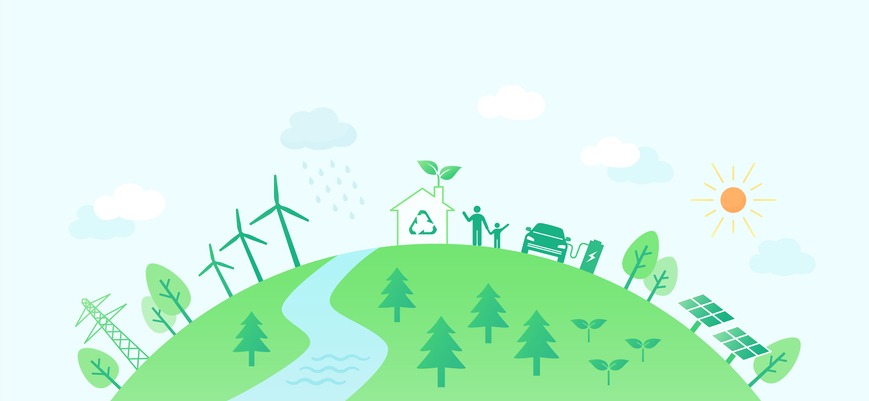
There are plenty of small and actionable steps schools can take in their efforts to reach net zero – discover what they are below
CREDIT: This is an edited version of an article that originally appeared on Sustainable Schools
In an era where environmental consciousness is paramount, educational institutions bear a profound responsibility to lead by example and instil sustainable values in the next generation.
Embracing sustainability not only reduces ecological impact but also empowers students with the knowledge and mindset needed to address pressing global challenges. These actionable strategies provide a roadmap for schools to effortlessly integrate sustainable practices into their daily operations, fostering a culture of environmental stewardship that resonates far beyond the classroom walls.
Switch to a Renewable Energy Supplier
If setting up an off-grid power system to generate your own renewable energy isn’t feasible, the next viable option is to transition to a provider offering a green energy tariff sourced entirely from renewables. Switching energy suppliers is a straightforward and swift process that can substantially reduce your carbon footprint.
Building Improvements and Buildings Management Systems
Implementing building enhancements, including insulation installation, LED lighting adoption, and automated light sensors, can yield substantial outcomes. Even repairs on existing structures or simple adjustments like strategically placing blinds can result in significant improvements. Modest alterations such as decreasing indoor temperature by 1ºC or reducing operational hours by an hour daily can lead to savings of 5-10% on heating expenses.
Conducting an energy assessment for your school is a cost-effective measure, providing tailored recommendations to curtail consumption and expenses. This assessment report should outline the investment costs along with the corresponding payback period, ensuring informed decision-making.
Rainwater harvesting
This can be useful for maintaining school grounds, water may even be utilised in other ways (such as for flushing toilets) inside the building. Rainwater harvesting and perhaps even grey water systems are key things to consider if you want to find another way to make your school more sustainable.
Switch to Sustainable Procurement for School Meals
We are what we eat. Switching to sustainable procurement for school meals can make a massive difference and in many cases is something that is relatively easy to do.
Sustainable food is food which has been grown, prepared, packed and delivered in a sustainable way. It should be fresh, local, seasonal and organic.
Where possible avoid imported food where there are significant ‘food miles’ attached and is often packed in unnecessary single use plastic. Reducing meat and dairy consumption and increasing plant-based alternatives can help your school eat in a more sustainable way.
Working with your suppliers to increase the portion of local produce and reducing the frequency of deliveries is key. If you purchase your school food through a buying organisation, check what standards and checks are in place.
Waste-Free Procurement
Reducing waste is not just about what leaves the school, but also what you allow to enter it in the first place. When thinking about procurement for paper, stationary, books, uniforms, technology, and all the other things your school needs, always keep waste in mind. Aspire for zero waste, not just on the premises, but throughout supply chains.
Try to choose suppliers who can offer items which are fully recyclable or compostable and opt for suppliers who deliver without excessive or non-recyclable packaging.
Encourage staff and pupils to make recycling habitual, installing well labelled recycling bins in all classrooms and common areas across the school. Your local waste service provider should be able to advise on the recycling services available in your local area, many are free, some can even provide a small revenue stream to school.
Encourage Sustainable Travel to School
You may already have taken some steps to encourage people to car share, walk or cycle to school. You should continue to try to incentivise and make it easier for staff and pupils to do so.
Encouraging people to cycle to school can be enhanced by running cycling proficiency classes, installing a bike shed on site, or even starting a swap shop where people can repair/ trade second-hand bikes.
Integrating Sustainability into the Curriculum
Establishing sustainability as the new norm encompasses more than just taking actions to reduce the school’s carbon footprint and enhance its sustainability.
Ensuring that both staff and students fully comprehend sustainability is a pivotal stride. Educators can foster ingrained behaviours through integrated learning, and Positive Planet offers educational resources to complement curriculum teachings.
Incorporating students into your initiatives and gauging their accomplishments can be gratifying and underscores the collective influence of individual endeavours.
Engage with the Local Community and Lead in Transition Efforts
To achieve genuine sustainability, expand your vision beyond the school premises. Your school can spearhead a constructive influence in the broader community and supply chain.
Schools can contribute to raising awareness and educating parents and community members by hosting events or participating in the Positive Planet referral scheme, which financially rewards the school, channelling funds towards green initiatives.
Propagating sustainability throughout a community often involves imparting sustainable skills. Workshops focusing on gardening, cooking, DIY, repair, sewing, and other crafts can transform the school into a hub for sustainability, amplifying its value.
Nurture a Nature-Centric Learning Environment
A school garden stands as an ideal setting for students and adults alike to disconnect from screens and immerse themselves in a wholesome, natural backdrop. Nature-based learning environments and access to nature play a pivotal role in cultivating tomorrow’s sustainable, eco-conscious citizens.
Creating spaces within the school premises (where feasible) for wildlife to thrive can foster positive learning experiences and enhance mental and emotional well-being. Teaching the interconnectedness of all life can reshape our perspective on nature, fostering critical thinking and effective communication.
Global Perspective
Understanding the universal impact of climate change on all regions imparts the lesson of interconnection and underscores the significance of the school’s initiatives and constructive contributions. Collaborating with neighbouring schools on sustainability goals can amplify impact.
Aligning your school with a UN-certified project can offer deeper insight into the direct global contribution you are making.


Be the first to comment